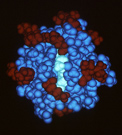DTP Branches and Offices
Milestone (1994)

3D images are created so researchers can visualize minute structures. Courtesy of NCI. 1982.
DTP Website inaugurated
Before the DTP Website came online, when a researcher requested registration of a compound, DTP staff drew the structure by hand and forwarded the drawing to Chemical Abstracts Service (CAS) in Columbus, Ohio, where it was entered into a computer database. Today suppliers submit their own compounds for evaluation using an online form.
In 1994, DTP launched its Website, making its drug discovery and development services and the results from the human tumor cell line assay publicly accessible to researchers worldwide. At first, the site offered in vitro human cell line data for a few thousand compounds and in vitro anti-HIV screening data for roughly 42,000 compounds. Today, visitors who come to the site can find:
- Downloadable in vitro human tumor cell line data for some 43,500 compounds and 15,000 natural product extracts,
- Results for 60,000 compounds evaluated in the yeast assay,
- In vivo animal model results for 30,000 compounds,
- 2D and 3D chemical structures for more than 200,000 compounds, and
- Molecular target data, including characterizations for at least 1,200 targets, plus data from multiple cDNA microarray projects.
In addition to browsing DTP's databases and downloading data, researchers can request individual samples or sets of compounds on 96-well plates for research, or they can submit their own compounds for consideration for screening via DTP's online submission form. Once a compound is submitted for screening, researchers can follow its progress and retrieve data using a secure Web interface.
Built and maintained by DTP, the database is a collection of three-dimensional structures for more than 400,000 drugs, which investigators use to screen for anticancer and anti-HIV therapeutic activity. Before the database was established, the structural information stored in the Drug Information System (DIS) was only the connection table for each drug.
The connection table is a list of the atoms that are connected and a description of how they are connected. This information can be searched to find drugs that share similar patterns of connections, which can correlate with similar biological activity. However, the cellular targets for drug action, as well as the drugs themselves, are three-dimensional objects, and, in many cases, the important points of interaction between a drug and its target can be represented by a three-dimensional arrangement of a small number of atoms.





